I’ve decided to cross-post content I’ve written for other sites on this blog, if only to keep it readily accessible to me…
These reviews were previously posted in the Mospeada thread at Macrossworld.com.
I thought my fellow Mospeada fans would be interested in seeing how Wave’s 1:72 Legioss model compares with the old Imai release. While Imai produced kits of all three modes in this scale, Wave’s Legioss is “Armo-Soldier” only.
None of these kits are currently in production, and aftermarket prices are always in flux; the most readily available to me was Aoshima’s release of the Imai kit from a decade ago (specifically, Houquet’s “Zeta”). Wave’s “Iota” was the cheapest of theirs I could find, so we’re comparing a vintage red kit with a modern green one.
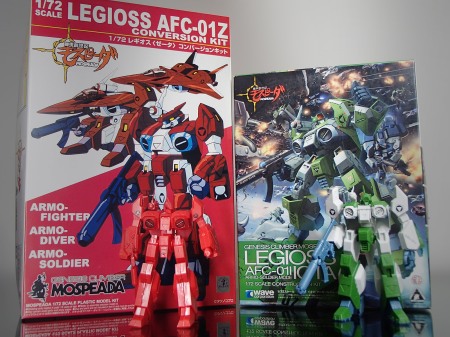
While the Wave’s only slightly taller than the Imai, individual parts and proportions vary wildly from each other. The Wave has larger shoulders, wider legs, a much larger nosecone on the back, and absurdly large hands, required to carry that massive gunpod of his:
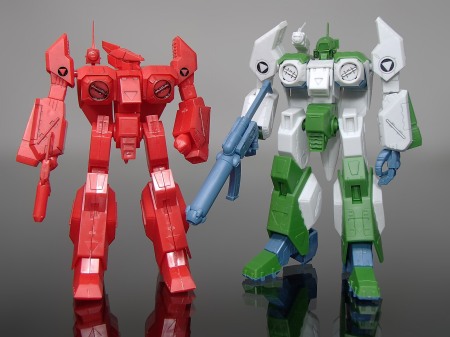
The Imai has a wider chest, very small hands, and a ridiculously tiny gunpod that can’t be held properly unless it’s glued into the hand…
Other than a little black wash to bring out some of the sculpted detail, I haven’t applied any paint to these kits yet. What you see is the color of the plastic the parts were cast in — green, white and blue for the Wave kit, and red for the Imai — and clearly, both will require substantial painting. There are white parts of the Wave kit that need to be painted green, and green parts that need to be painted white, so it matters little what colors the parts were cast in; everything’s gonna need paint anyway.
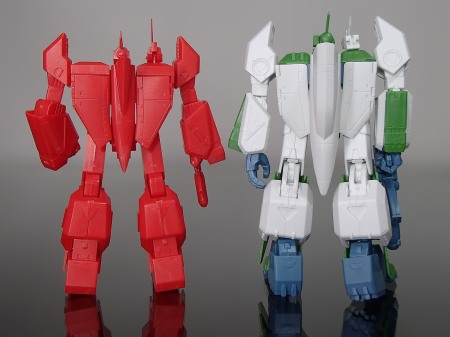
As is typical of ’80s kits, the Imai is rife with unsightly seam lines and misaligned panel details, and will definitely require a lot of cleanup work before painting; the Wave does a better job of hiding most of the seams, making it easier to build and requiring less glue to assemble.
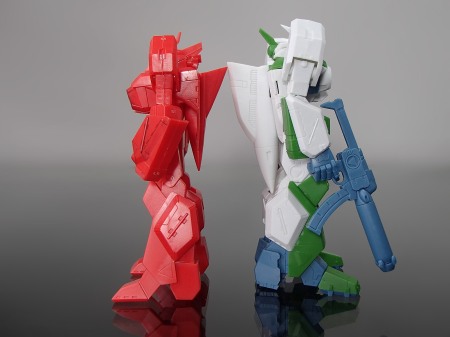
Also typical of modern Japanese kits, the Wave uses plenty of PVC poly-capped joints to aid in articulation. The Imai is well-articulated for its time, but can’t compare with the poseability of a modern robot kit.
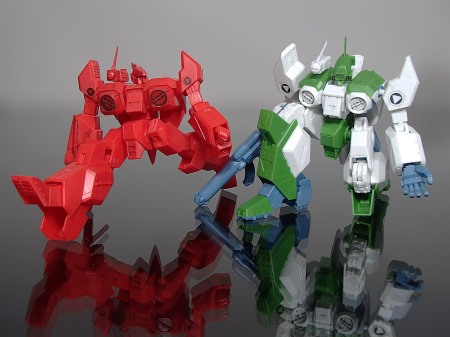
However, fans will notice a lot more deviation from the animation line art when it comes to sculpted detail on the Wave — the shoulders, legs and feet in particular — and there are a lot of recessed panel lines that don’t exist in any other depiction of the Legioss. If you want your model to be anime-accurate, you’ll probably want to sand off or fill in some of those egregious details with putty and paint over them.
I haven’t decided exactly how I want to proceed with my build from here, but I’ll probably do some mixing-and-matching of parts to come up with the most accurate Armo-Soldier I can. The chest intakes and shoulder-mounted sensor array are more accurate on the Imai, but I prefer the overall proportions and the articulation of the Wave kit. Neither kit comes with adequate hands, so I’ll likely use 1:144 scale Gunpla aftermarket hands instead. The feet on the Imai kit are closer to the animation model, but I prefer the aesthetics of the boots on the Wave… but those “cleats” have got to go!
Anyway, the real reason I bought that vintage Imai 3-in-1 kit was for the 1:72 fighter:
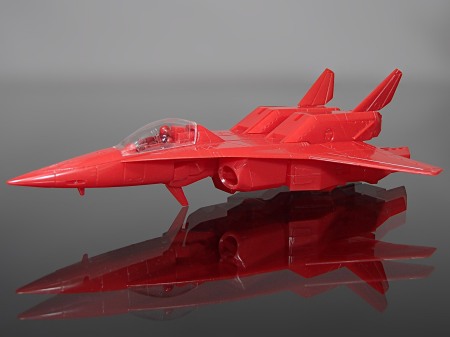
Every other toy or model kit representation of the Legioss has favored the Armo-Soldier mode, which means fighter mode (if it’s even capable of transformation) is plagued by a short, round nosecone, large arms overwhelming the fuselage, and legs that dominate the back half of the jet (usually amounting to nearly 50% of the volume). The tail fins are never canted at the right angle, the fuselage is never straight along the horizontal axis, and the feet always stick out much too far. This vintage kit is the most (if not the only) accurate Armo-Fighter ever produced.
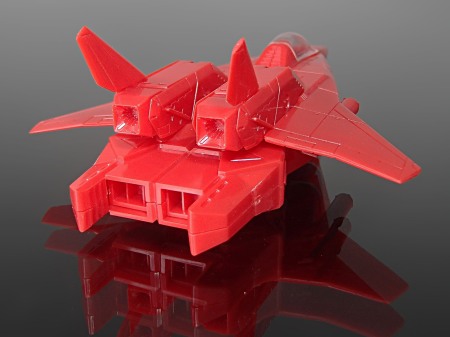
Here you can see the engines in proper proportion to the rest of the fighter, as depicted in the original designs and in animation. The engine nacelles have realistic depth to them, and the tail fins sit at the proper angle.
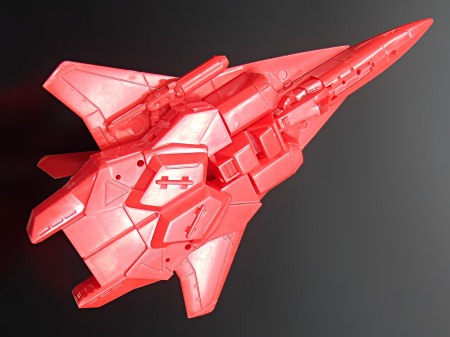
The underside cleans up nicely, and the legs appear to be folded up in a way that no engineer has ever managed to achieve in a transformable toy. Also, we see why the gunpod appeared so ridiculously small on the vintage Armo-Soldier kit; it was clearly scaled for fighter mode instead, and under the wing it looks pretty close to the size it was drawn in the animation model sheets.
You can see where guide holes have been placed to install landing gear, or panels to conceal it (if you want to pose it in flight), and I intend to keep both display options viable.
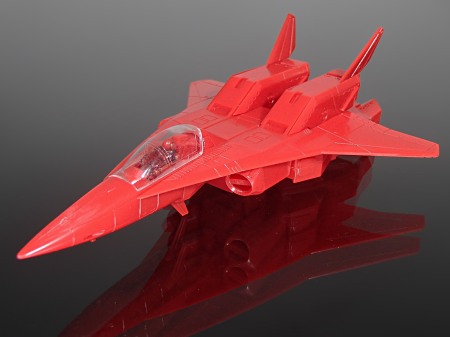
It’s not perfect, of course — the cockpit is severely lacking in detail, and the pilot seat is much further forward than it should be — but compared to the 1:72 Armo-Diver or Armo-Soldier kits (or the 1:48 transformable models), this one’s far more accurate, easier to construct and paint, and ultimately much more satisfying. Of all the Mospeada kits I’ve bought and put together over the years, this one gets my highest recommendation.
Next up:
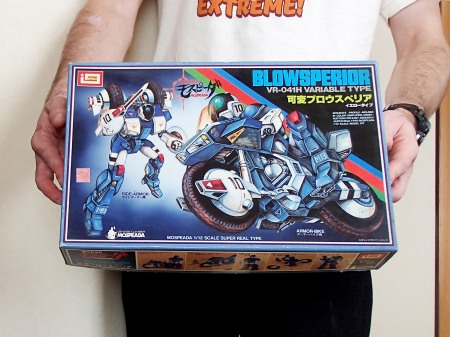
Imai’s 1:12 variable-type [sic] VR-041H “BLOWSPERIOR” comes in a surprisingly large box, adorned with the usual gorgeous paintings and bullshit English text —
What? You didn’t realize “Blowsperior” was a mistake? Seriously?
Well, it should come as no surprise that Shinji Aramaki is a vintage motorcycle enthusiast, and that he named Yellow’s specialized ride armor after a high-end line of British motorcycles designed by George Brough. The “Brough Superior” was the first sports bike, and Brough Superior motorcycles are still prized by collectors to this day.
It galls me that, after three and-a-half decades of advancement in the field of information technology, fans around the world continue to refer to the VR-041H as a “blowsuperior,” years after we’ve learned “Stick” is actually Stig (a Scandinavian name) and “Fuke Eroze” is supposed to be Hoquet et Rose (a French name). Tatsunoko marketing execs in 1983 were only concerned with the Japanese market, and had no Internet access; they simply didn’t know any better. We have no such excuses, however, so let’s put an end to this here and now. It’s Brough, not “blow.”
Got it?
Good.
Anyway, despite the wide variety of Mospeada toys produced over the last 35 years, this vintage kit remains the most accurate rendition of the Brough Superior released (since Beagle folded before they could put their version into production). Let’s take a look inside the box, shall we?
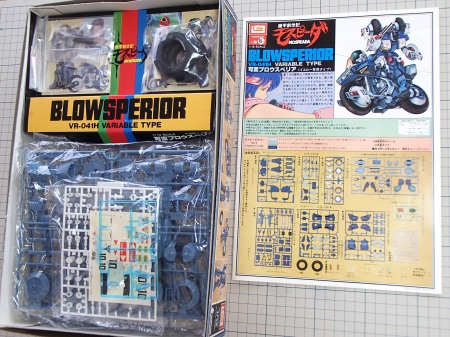
There are numerous parts on multiple sprues (over 150 parts, all told), including real rubber tires, die-cast metal joints, screws and springs. Since it’s designed to be transformable, there are a lot of complex moving parts to assemble.
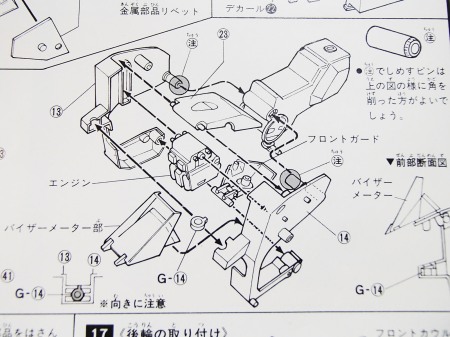
Another mistake on the packaging is where it says “simplified construction for easy assembly,” ’cause it’s not. The instructions are sometimes inadequate (especially if you can’t read Japanese!), making for a difficult build, even for someone with considerable modeling experience. In some cases, you’ve just gotta muddle your way through and figure it out as best you can.
There are points in the instruction manual where Mospeada characters provide advice, but it’s not particularly helpful:
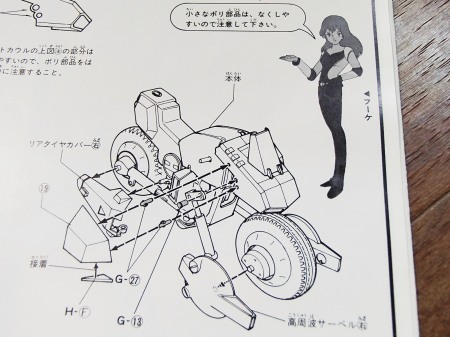
For example, Hoquet’s word balloon says “Be careful not to lose those tiny parts.” Good advice, sure, but not very informative. ![]()
Once you get it together, though, it really looks the part. ![]()
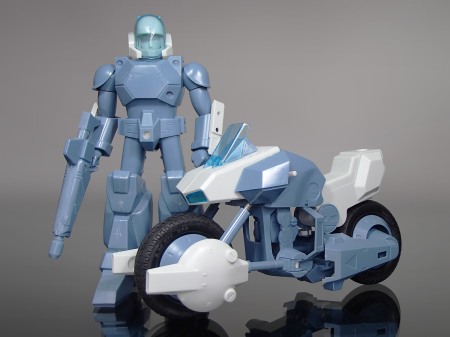
The figure and bike are both well-proportioned (look at the size of those tires!), but articulation is somewhat limiting. There’s no elbow or thigh swivel — just a rather restrictive hinge — making it difficult to get a good riding pose, and no up-or-down movement for the head, either. Before I complete any of the subassemblies properly, I’ll definitely be adding additional ball joints to bring the articulation up to modern standards.
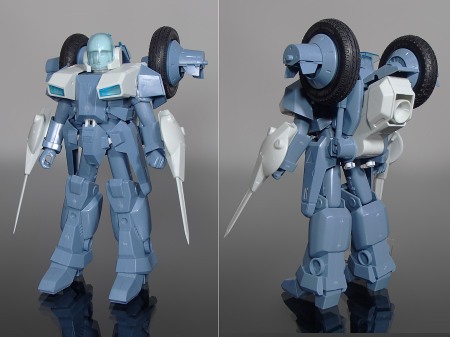
It’s not easy, but you can get the ride armor to stand unassisted if you find the right pose. It’s back-heavy, of course (like any Mospeada ride-armor), but not inordinately so.
Forgive the crude assembly; I’m just figuring out how everything fits together, and which parts will need painting first.
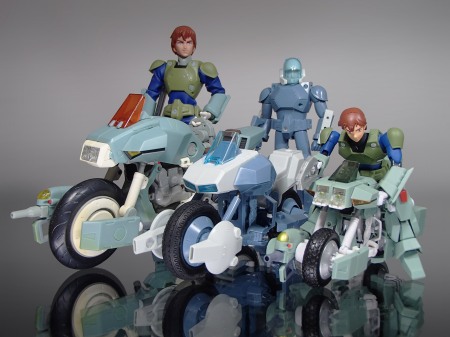
At 1:12 scale, it sits right between the 1:15 MegaHouse toys (right) and the 1:10 Beagle (left). I was hoping for parts a little bigger — to kit-bash a custom Beagle “Brough Superior” — but I just don’t think the scales are compatible.
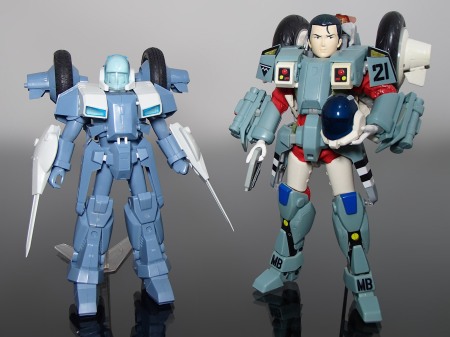
The boots would definitely be an improvement over those dainty Beagle legs, however!
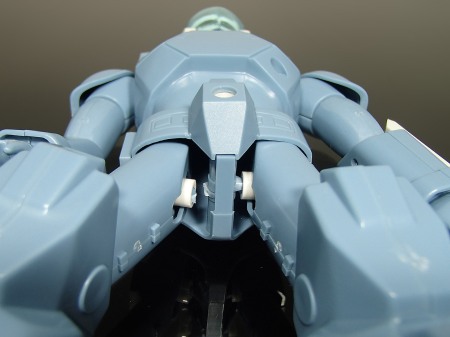
It’s important to remember that this isn’t a toy, and you have to be really gentle with some of the joints. It’s designed to be transformable, but given the fragility and the potential for paint rub, I’d advise against transforming it once it’s completed. You should probably decide what mode you want to display it in before you build it, and keep it that way.
Of course, having said that, I’m gonna have a hard time deciding which mode I prefer…! ![]()
I managed to acquire this kit for about $30 USD shipped — twice its original retail value, sure, but still a steal for such a large and complex model. If you’re an experienced modeler — and you can find it for a decent price — I highly recommend getting one.
It’s gonna look awesome once I’m done with it. ![]()
Now, for something a little simpler:
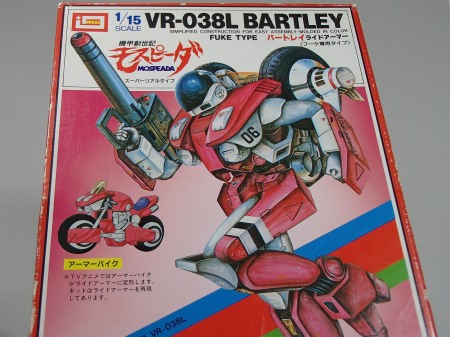
Imai’s 1:15 VR-038L “Bartley” kit has some misleading artwork on the package, representing Houquet (NOT “Fuke”) wielding her distinctive cannon in a dynamic action pose the figure is totally incapable of achieving, with a smaller image of the bike mode the figure is also totally incapable of achieving.
Since 1:15 is the scale the MegaHouse figures employed, I figured she could fit right in with the boys…
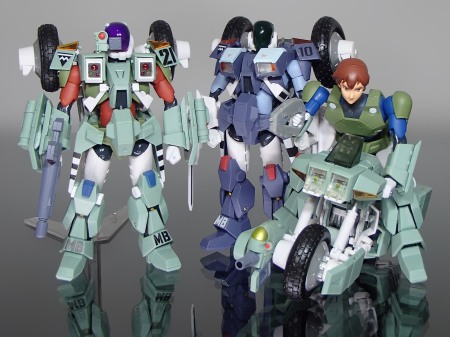
…since MegaHouse neglected to include a Bartley figure in their “Variable Action” line. ![]()
So what’s in the box?
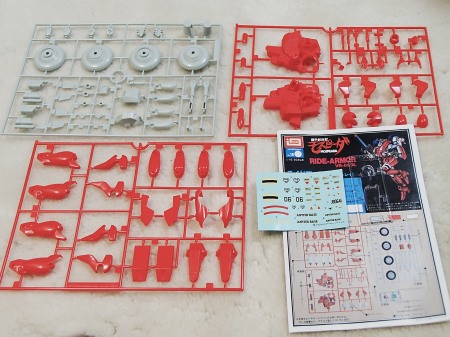
About 75 parts total, which is less than half the parts count of Imai’s 1:12 scale kits. Since this kit is considerably smaller and is fixed-form, it’s much easier to put together; the initial rough assembly you see here only took a couple of hours.
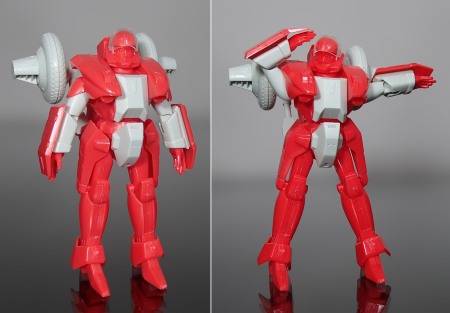
The figure is articulated about as well as could be expected for its age, but badly needs elbow, knee, and thigh rotation…
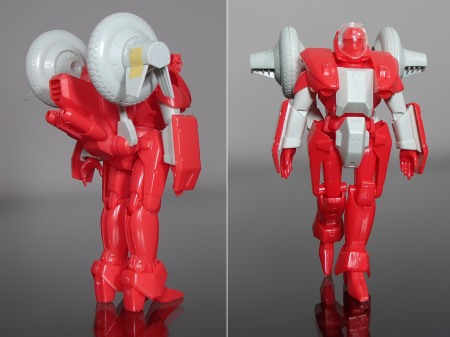
Nonetheless, even the stock figure is capable of some fairly feminine poses, thanks to its lightweight construction (and a great deal of patience!). ![]()
Unfortunately, the proportions are considerably less feminine.
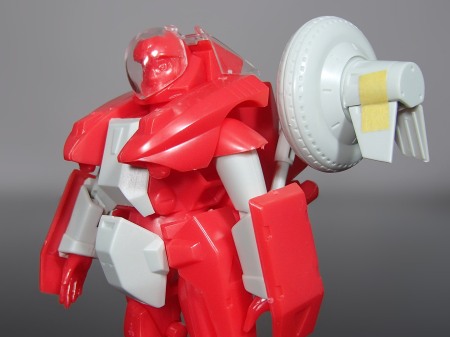
One detail came as a real surprise, however:
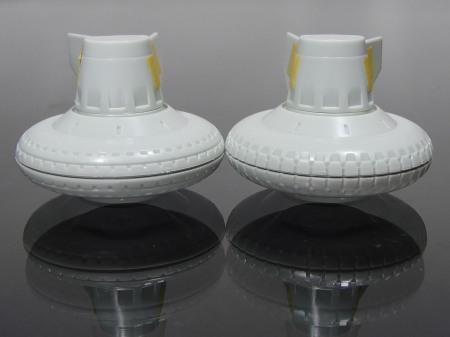
The front and back tires have distinctly different tread patterns! I’ve never seen that on any other Mospeada toy or model kit.
Anyway, how does she look with the MegaHouse boys?
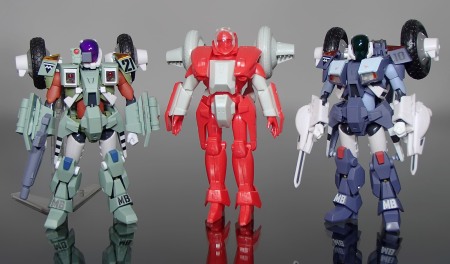
Pretty damned awful, I’m sorry to say. ![]()
She’s too tall, too fat, and too masculine — almost as if it were Jim wearing Houquet’s ride armor — and it’s gonna take a lot of customization to make her look like the lithe teenager she’s supposed to be.
Oh, and while Imai saw fit to include her targeting scope, they clearly forgot something:
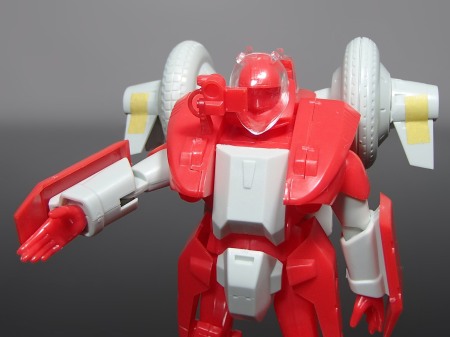 There’s no weapon included in the kit!
There’s no weapon included in the kit! ![]()
Fail, Imai. FAIL.
Hello! His report struck me as extraordinary. I am from Argentina and a few months ago I was able to buy the Imai’s 1:12 variable-type [sic] VR-041H “BLOWSPERIOR” but I lost the instruction manual to put it together. Would you be so kind as to share photos of each page with me? I’ve been searching the internet for a long time and I can’t find it. From now on, I will be eternally grateful to you !! I send a cordial greeting.
Luciano Oscar Páez.
lucianopaez77@gmail.com